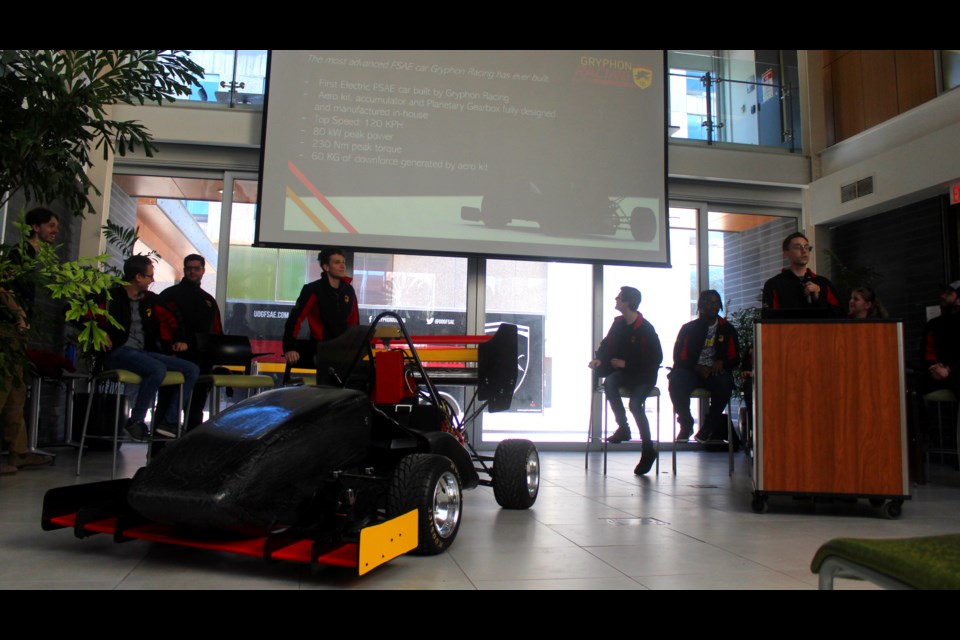The Gryphons Racing Club has officially gone electric.
The first electric car in the U of G club’s 22-year history – the GRC22 – was unveiled at the University of Guelph Saturday morning in front of a gathered crowd of teammates, supporters, family and racing team alumni.
“There’s a couple of us that have been around, so this is our third year of building this car,” said Ayden Bourdeau, the team captain for GRC and a fourth-year U of G computer engineering student in the co-op program.
“Electric vehicles are very difficult to build. This car means everything. I’ve really put everything I’ve had into this team for the last three years.”
Starting this project in the midst of the pandemic did prove to be a challenge.
From manufacturing to supply shortages, to not being able to compete because of border closures, it became tricky.
But that’s in the past, and Bourdeau is just happy to get to this day and the car finally revealed to the public for the first time.
Going electric was natural, he added, with the industrial shift to electric vehicles.
“A lot of teams are moving to electric now, and the competitions aren’t really filling up as much as they used to,” he said. “Hybrid and electric are definitely where the industry is going in terms of Formula 1, and performance and that kind of stuff too.
“It’s really awesome to endeavour in this, and bring the idea of electrical engineering, which is finally coming to Guelph, to the University of Guelph as well. It’s really awesome.”
The car itself seats one, and can reach speeds of up to 120 km/h, though that can be limited.
The on-screen digital dashboard shows a number of things, from the temperature of the oil, coolant and motor, to the current speed and how much power is left in the battery.
The GRC, which has been around since 2002, has built a number of cars over the years.
But this one is being touted as the most advanced of them all.
And it’s all-hands-on-deck. Bourdeau said about 60 people contribute more than 10 hours a week right now.
Bourdeau himself is up to about 60 hours just this week. Many on the team barely slept, putting some final touches, on top of schooling at the same time.
“When we first started this car, there was about eight or nine of us,” he said. “We were trying to figure out how to do all of this new EV infrastructure from scratch, and also stay competitive.”
From September to December, the design work will usually take place, and then manufacturing will run from January until the competition begins in June.
“Now that we have our first electric vehicle, we kind of have a template for the teams moving forward,” Bourdeau said. “A lot of this stuff can be reused and we can go to competitions every year and just keep improving on our designs that we have now.”
Later this month, this car will be brought to New Hampshire for the Formula Hybrid student design competition.
In June, the team heads to the Formula SAE Electric competition in Michigan.
Ahead of time, Bourdeau said the car runs, but there is still some work to do before the competition gets underway.
There are a number of aspects to the competition, and there isn’t any wheel-to-wheel racing.
Judges will run tests on every single part of the car during acceleration to endurance events, just to name a couple.
The thrill of the competition is one thing that drove these students to participate.
For Bourdeau, it was his love for learning and wanting to be part of a club that helps fulfill that need that got him to the GRC.
“It’s crazy to think that I was in first year, and I didn’t even know something as simple as turning on a light on a circuit board,” he said.
“And now I’m building a full 600 volt, custom-made accumulator pack with all of these complex circuits. It’s really remarkable to me. It kept me focused, and it’s nice to talk to other teams and learn this stuff.”
It has its benefits beyond post-secondary education.
Matt Aziz, who is the team’s dynamics captain – basically responsible for “anything that moves” on the vehicle, from brakes, suspension, aerodynamics, ergonomics and more – is a fifth year mechanical engineering student at U of G.
He said he was a Formula 1 racing fan before heading to school, and jumped at the chance to join the club.
But he also recognized the benefits of the club for his future engineering career aspirations.
He said many big companies look for Formula SAE experienced students.
“I would love to be a Formula 1 engineer or just an automotive engineer at a motorsport team,” he said.
“It doesn’t have to be Formula 1. I love cars, I love designing them, I love racing them and I want to continue doing that in my professional career.”
